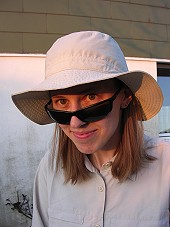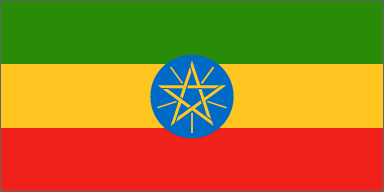
MARTINA'S WORLD TRIP
ETHIOPIA: May 18 - June 1, 2004


(Übersetzungshilfe)
 |
MARTINA'S WORLD TRIP ETHIOPIA: May 18 - June 1, 2004 |
|||||||
 |
||||||||
 |
Your Dictionary
(Übersetzungshilfe) |
|||||||
| Monday, May 31st, 2004 - Omo Valley Tour Day X | |||||||
| Monday, May 31st, 2004 Omo Valley Tour Day X (back to Addis Abeba)
The last day of our tour begun with a drive to Lake Ziway, not far from Langano. Measuring 400 sq m, Lake Ziway is the largest of the northern group of Rift Valley lakes. It lies about 1,5 km east of the town of Ziway where we had our breakfast. I hadn’t been the greatest fan of Ethiopian cake so far (it’s usually quite dry and neither sweet nor especially tasteful) but I was happy to discover some good stuff here. We also went to see the lake which is surrounded by blue volcanic hills and well known for its birdlife. Nati drove us to a spot where there was supposed to be a fish market but apparently, we were too late. Only very few fishermen were left. Sadly enough, the place was filled with horses, dogs and donkeys with strange-looking open wounds and tons of flies around them, which did not really invite us to stay. From Ziway we drove towards Butajira and were surprised about the excellent road conditions. Coming out of the Omo Valley, an asphalt road was almost heavenly comfort for us. Nati explained that this road’s construction, as well as many others in Ethiopia, was actually sponsored by the Chinese government as part of a development programme. Who would have thought of a connection between China and Ethiopia?? Our next stop was Tiya, a small village approximately 100 km south of Addis Ababa. Close by the village, we visited an ancient site of standing stones. The site contains around 40 stelae, lined up in rows, groups or circles, the largest of which stands up to 2m high. Almost nothing is known about the monoliths’ carvers or their purpose. Most of the stones are engraved with enigmatic symbols, notably swords. A local guide told us that the number of swords displayed on a stone showed how many people a warrior had killed during his lifetime. He could distinguish between gravestones for male and female bodies and had a lot of interesting things to tell about the stones and their history. Apparently, a team of French archaeologists had worked on the site in recent years and the results of their research were summarised in a huge book the guide showed us. In the end, yes, it was just stones, but still a fascinating place to visit. After Tiya we continued our way and did a little d-tour of 13 km to visit the rock-hewn church of Adadi Maryam which is believed to date from the 12th or 13th century. The church is a ¾ monolith and supposed to be impressive. Unfortunately, the guard wanted us to pay 30 birr each and as much as we would have wanted to visit the church – not for that price. So we left without having seen it. Approximately 30 km ahead of Addis Ababa we stopped for the last time to check out a place called Melka Kunture. It is famous for a remarkable prehistoric stone tool factory discovered in the 1960s. Extending over 5 km on both sides of the river Awash, it encompasses more than 50 prehistoric sites dating as early as 1,7 million years ago. In case you didn’t know: Lucy, the world’s oldest and most complete human skeleton, was also discovered in Ethiopia. Lucy was a ‘hominid’, a kind of half-human-half-ape, and at least 3,2 million years old. (Her name derives from the Beatles’ song “Lucy in the Sky with Diamonds”, which happened to be playing in the archaeologists’ camp at the moment of her discovery.) Here in Melka Kunture we didn’t see human bones but a lot of other interesting fossils were on display, including some tools used by the homo erectus / homo sapiens who once inhabited the area. Thanks to a series of explanatory panels and a museum hosted in small huts around the site, a guide wasn’t necessary. Nevertheless, one of the workers led us a little bit further into the fields to a small site that was presented in such a way as if it was currently under excavation and you could clearly see animal bones and tools sticking out between the stones in the ground. Amazingly enough, visiting this place was free which we acknowledged by giving a generous tip. In the end, our last day was a nice mix between driving and visiting different places. When we arrived in Addis in the late afternoon, we first went to a travel agency at the Hilton Hotel because we all wanted to organise our onward travel. In the meantime I had decided not to cross the border to Kenya overland and just asked them for the cheapest flight south, no matter where, as long as it left the next day. My options included Nairobi (Kenya), Arusha (Tanzania) or Kampala/Entebbe (Uganda). As it turned out, the cheapest was a flight to Kilimanjaro Airport in Tanzania. First, there were no seats left for tomorrow and the lady at the travel agency put me on the waiting list. I just began to accept the fact that I would have to wait until Thursday before I could leave Ethiopia, when she prepared to print out my ticket and suddenly her computer system came up with a message about a free seat for tomorrow’s flight. Thanks to my angels, I was lucky again. While the others were still at the travel agency, I checked out the hotel’s facilities and the foyer. It was amazing: coming out of the bush, all these people in their suits, the marble floor and shiny walls, thick carpets, computers, souvenir shops and leather sofas looked so surreal. I had to remind myself that I had stayed in Hilton Hotels during my business trips before but suddenly I saw everything that used to be familiar with different eyes. One thing I missed a lot during our Omo Valley Tour was – guess what – CHOCOLATE!!! I think there was no single day I didn’t get on the guys’ nerves with “Oh, I really wish I could have a piece of chocolate now!” So when I saw a book at one of the stands in the Hilton foyer, I simply had to buy it. It was called “Chocolate for a Woman’s Soul”... With all our flights sorted out, our tour finally ended and Nati dropped us back at the Baro Hotel. Remember, it’s the place where I had booked my very first night in Ethiopia. Xavier, Ihab and Mohamed had their rooms here and I asked if they had another single available. They said yes and I was happy to be able to spend my last night in Addis Ababa with ‘my guys’. As soon as we had unloaded the car and said good-bye to Nati, I went to an internet place to check my emails and tell the rest of the world that I had survived the Omo Valley. What a shock when I had over 6600 emails in my mailbox! I couldn’t believe it, thousands of spam mails! I have no clue how that happened, so in search of some ‘real’ emails, I started to manually delete messages. I think I spent two or three hours at that place, deleting as many as 2000 emails and found perhaps three non-spam messages. What a nightmare. Later on I informed my parents and gave them access to my account, so in the following days we worked in shifts to delete emails but at some point I realised that for each three messages you delete, at least one new one comes in every 3-5 minutes. It was terrible. A few days later, my Dad had to contact the service provider and my whole email account had to be reset. Unfortunately, this deleted ALL emails in my mailbox, also the ones I had kept there to reply to. So if anyone of you wrote me during this period and never got an answer, chances are I never got your message... When I finally got tired deleting emails, I returned to the Baro Hotel. Apparently, this hotel has a serious problem with their bookings: When I arrived they told me they made a mistake and they actually had no room for me tonight. I couldn’t believe it! It was evening by now and I really didn’t feel like going out in the streets again to search for accommodation. Luckily Xavier was there as well and together we convinced the receptionist to let me sleep on the floor in Xavier’s room. It wasn’t the most comfortable solution but at least, I didn’t have to pay for it. (The next day they tried to charge me anyway but I refused.) Later this night I went for dinner with Xavier, Ihab and Mohamed to celebrate our last evening together. We went to a very small Italian restaurant that was run as a family business and I had – of course – pizza. This one was much better than last time, so in the end, I left Addis Ababa with at least one good restaurant in mind. |
|||||||